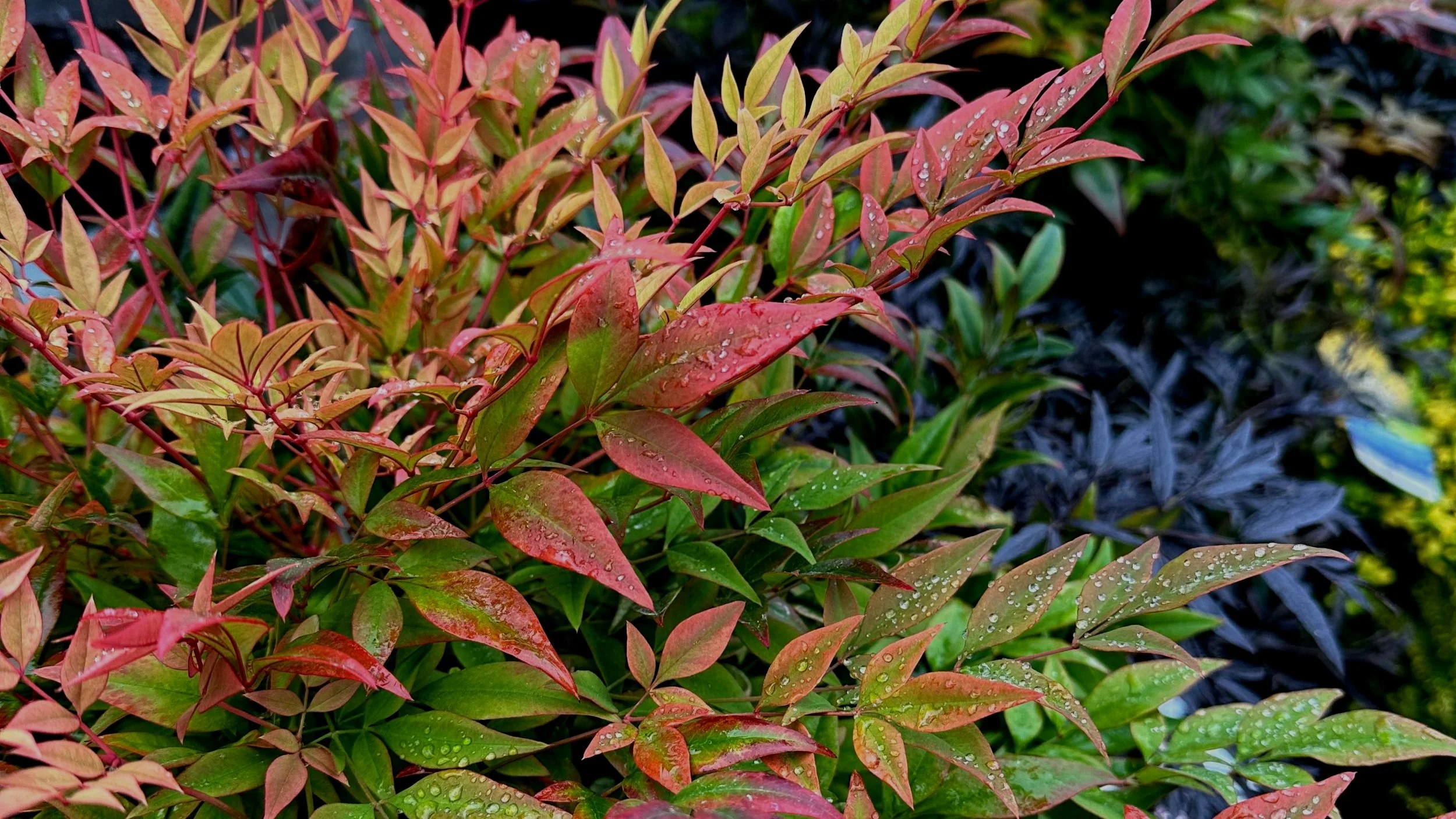In our PNW climate, there is so much to appreciate about the fall season. Gardeners are in the midst of harvesting their summer bounties of edibles and getting their gardens ready for the coming winter, all the while pondering where to move this plant, when to divide that one, and where to add something new. As we have been discussing the last few weeks, and will continue to do so, the fall season presents perfect timing for many garden projects and an ideal opportunity to get ahead for the upcoming gardening season. But this week let us put our shovels down, pause for a moment, take a deep breath of cool autumn air and enjoy the fabulous colors of the season.
The term “flagging” also deserves mention in this discussion as well. You may think of “evergreens” as being truly evergreen forever, but they are not. Conifers (and broadleaved evergreens for that matter) hold their foliage for three years, then naturally shed this time of year, getting rid of old that was replaced during the summer by new growth. OCD gardeners like myself gently rake the material out of their plants, where possible, and the rest drops as free mulch, which adds to the soil with time. A yearly recycling of old into new has happened since the beginning of life, so keep in mind that this is Mother Nature’s way. Noticing that Cedars, Pines, and other needle-bearing conifers are turning brown in the center is not necessarily a problem. When we see dead tips, fresh growth gone bad, or sections/limbs of a tree dying then yes, Houston, we have a problem.
One aspect I love about my job is interacting with local gardeners, listening to what they desire in their landscapes, and frankly, acting as a plant enabler. Here are a few thoughts I have on some repeated discussions I seem to have with nursery patrons year after year, especially in the fall…
Far too many gardeners ignore deciduous shrubs and trees, gravitating only towards “evergreen” plants. A well designed and balanced landscape should contain both, remembering of course that deciduous plants are the ones that provide us with the stunning colors of autumn. They add varying foliage, different textures, and often contrast with their evergreen cousins. Look upon your landscape and remember that deciduous plants can be your garden friends as well. Working them into your garden oasis will add some serious interest, including foliage color in the fall.
Don’t forget that many perennials, like Peonies, turn bright colors before going dormant with frost. For example, Itoh Peonies provide as much color in my own landscape as some of my Japanese Maples. The vast majority of perennials will melt to the ground after hard frost, but until then, many are glowing with fall color. Keep in mind that subtle tans, rusts, and even shades of brown add seasonal interest in the garden too, especially when blended with brighter shades of yellow, orange and red.
I get asked year after year a simple question by many nursery patrons; “Why does my yard turn only yellow and brown, and then I see native areas glowing with oranges and reds?” The answer is water, as far too many gardeners water their established landscapes too often for too long in our neck of the woods. Over watered gardens, especially in late summer to early fall, is often the culprit. Those with sprinkler systems should be reducing both the frequency and duration of their schedules. Hand waterers like myself should not be watering in late August and September as much, as plants need to harden off in fall. Try to ride the line of drought stressed, without burning foliage off course, and save some water in the process. This applies to established gardens, so remember to still adequately water younger specimens a bit more often.
This is the perfect time of year to visit your local Garden Center and see great fall plants live in vivid HD color! For example, it is tough to verbally describe what a Burning Bush looks like… Is it scarlet, or rather a pinky red, or just red? Your own eyes will be much better at finding the right color tones to match your taste. There are far too many excellent choices that turn spectacular color this time of year to mention, but here are a few worth consideration, especially exploring specific varieties of each to match that special spot in the landscape.
Deciduous Shrubs for Fall Color: Japanese Barberry (Berberis thungergii), Sweetspire (Itea), Burning Bush (Euonymus alatus), Disanthus, Chokecherry (Aronia), Oakleaf Hydrangea (Hydrangea quercifolia), Smoke Bush (Cotinus), Spiraea, Diervilla, Laceleaf Japanese Maple (Acer palmatum dissectum) and Viburnums of all kinds including Snowball Bush, Doublefile Viburnum, Cranberry Viburnum and Pink Dawn Viburnum.
Deciduous Trees for Fall Color: Redbud (Cercis), Korean Dogwood (Cornus kousa), Stewartia, Paperbark maple (Acer griseum), Black Gum (Nyssa), Sweet Gum (Liquidambar), Crabapple (Malus), Serviceberry (Amelanchier), Japanese Maple (Acer palmatum), Red Maple (Acer rubrum), Katsura Tree (Cercidiphyllum), River Birch (Betula nigra), Ginkgo, Crape Myrtle (Lagerstroemia), Red Oak (Quercus rubra) and Witch Hazel (Hamamelis).
Now that we are in the midst of autumn, it is time for all of us to gaze upon the vibrant colors of the fall season. As we drive around here and there in our busy lives, note the bold yellows, glowing oranges, and bright reds beginning to shine. The essence of autumn is beyond magnificent in my opinion! We owe some serious gratitude to Mother Nature for nurturing so many garden treasures for us to enjoy in our climate. We often say “don’t forget to stop and smell the roses” in the summer, but this time of year I implore all of you to pause and gaze upon the glory of autumn. Whether in your own landscape, a local park, a neighbor’s garden or in our lovely local native habitats, the fall foliage will surely bring a smile to your face.



